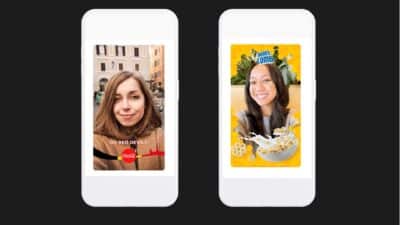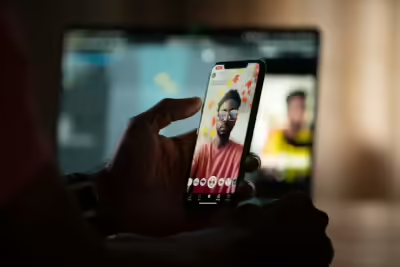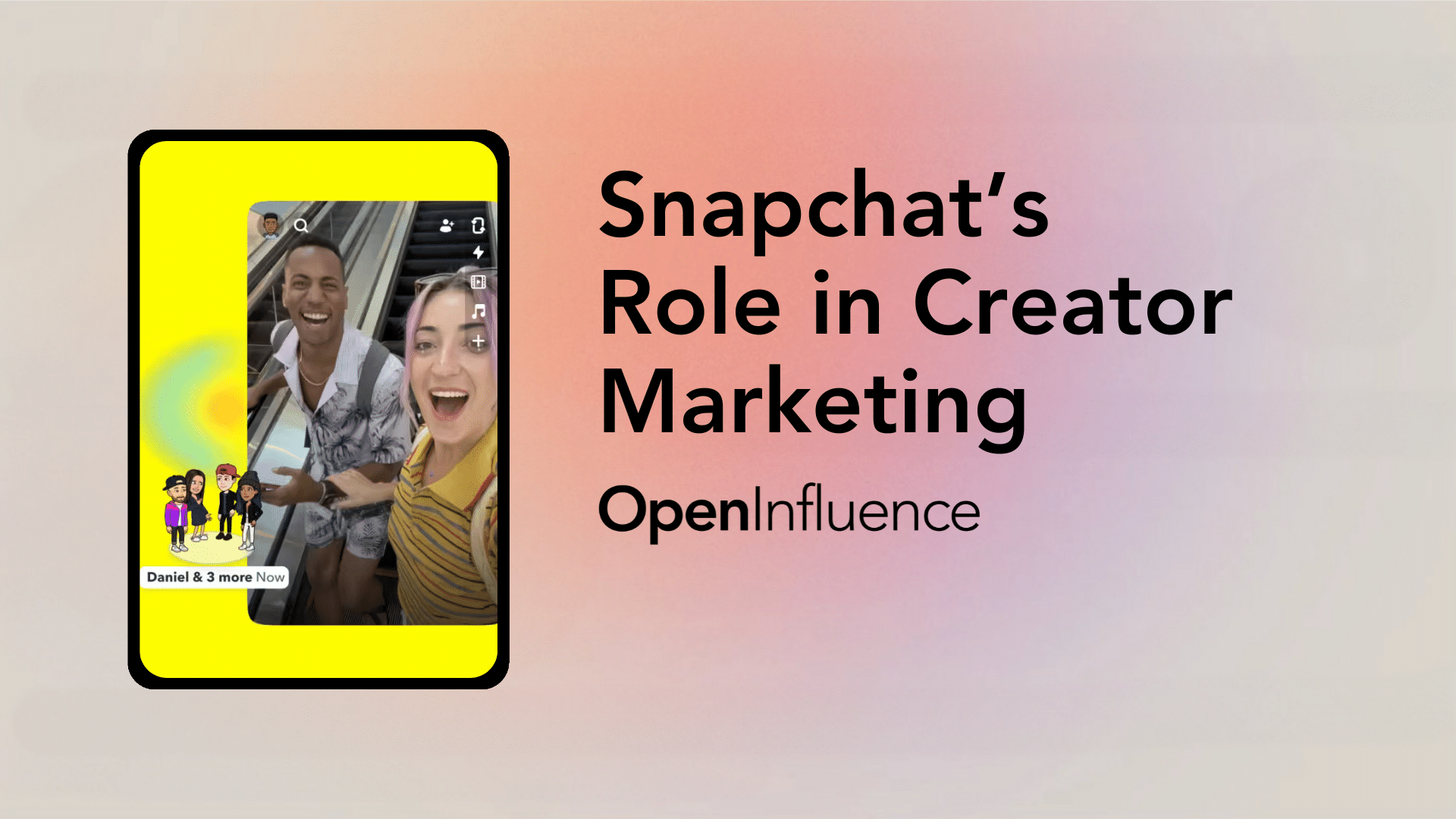Platforms like Instagram, TikTok, YouTube and Facebook are staples in influencer marketing campaigns, but there is an underutilized social media application out there, with an estimated 734.8 million monthly active users worldwide and several unique characteristics, including a desire to distance itself from other social media apps.
That app, of course, is Snapchat, and it offers many of the same advertising options as other popular platforms, as well as a strong history of innovative augmented reality lenses, along with a different approach necessitated by its trademark disappearing messages (Snaps) and its stated mission of being less like social media.
“Somewhere along the way, the promise of social media changed,” the company wrote in a February blog post. “Everything it aimed to be, the gaps it was meant to bridge, the connection it was meant to foster, the joy it was supposed to bring started to feel different.”
Snapchat added, “But not on Snapchat. From the very beginning, Snapchat was built as an alternative to social media. Our founders designed Snapchat to be a fun way to send photo and video messages, in the moment, to their closest friends and family. Snapchat was never designed to amass huge ‘friend’ networks, compete for likes or offer an endless scroll of perfectly produced and carefully curated content. It was designed to be a place where you could be real.”
The app has carved a particularly strong niche with Generation Z, boasting a larger share of that demographic in the U.S. than its social competitors. Snapchat has 49.6 million Gen Z U.S. users, according to eMarketer, joined by 31.5 million millennials, 8.1 million from Generation X and 2.6 million baby boomers.
Those younger users are spending more time on the app: eMarketer found that while the average time spent per day by U.S. Snapchat users was eight minutes, that figure jumps to 24 minutes for those aged 18 through 24 and to 15 minutes for the 25-through-34 age group.
However, according to another study from eMarketer, just 22.4% of creators use Snapchat for influencer marketing—well behind Instagram (97.7%), Facebook (73.1%), TikTok (65.3%) and YouTube (55.1%). Should the “opportunity” alarm be sounding?

Advertising on Snapchat
Snapchat offers an array of advertising options like those available through other social platforms, but its use of AR is where it really stands out.
Agencies and brands can opt for:
- Single image or video ads appear in Stories and user-generated-content destination Snapchat Spotlight, and they are well suited for brand awareness, driving website traffic and retargeting users who have previously visited the site.
- Story ads, served between Stories, in the Discover feed and in Spotlight, are ideal for driving engagement, promoting timely messaging and providing information on products or services.
- Collection ads, served in Stories and Spotlight, show users images or videos in succession that they can tap through, and they are a good fit for ecommerce or lower-funnel objectives, capturing potential customers who have gone through the discovery and research phases of their journey and are close to deciding on a product or service.
- Agencies and brands can use Snapchat’s Lens Studio AR development platform to design AR lenses and other elements like interactive games and virtual apparel, tapping that technology to spark brand awareness, conversions and engagement. Snap also offers a shopping suite of AR tools that let users “try on” and interact with products.
- Dynamic ads are personalized ads tailored to each user’s engagement on the platform via automated ad creation and data, using Snap Pixel, a piece of JavaScript code, to measure the impact of campaigns and properly target ads.
- Product catalogs enable advertisers to provide relevant information about each product and deliver those ads to custom audiences determined via business-specific or product-specific data.
- Finally, goal-based bidding lets brands bid based on objectives such as app installs, clicks, impressions, landing page views, shares, Story opens and video views.
A Closer Look at AR Lenses
Snapchat’s AR lenses can help brands promote their products in unique ways.
Items such as clothing, makeup and shoes can be virtually tried on by users, who will see how those items may look on them before purchasing them.
AR lenses can also be used to drive awareness of important topics. Snapchat itself used the technology for World Restart a Heart Day last October, creating a filter that taught users how to perform CPR.
Snapchat offers several ways to organically promote AR lenses, including:
- Lens booths, where creators can submit their lenses for consideration to be included in the daily carousel on the Snapchat app.
- Discover Stories.
- When a user views a Story that includes a lens, they can swipe up to unlock that lens.
- The More Lenses option shows all lenses produced by a specific creator.
Creator Marketing on Snapchat
Snapchat breaks down influencers on its platform into two groups: creators and Snap Stars.
The company defines creators as those with public profiles, posting public Stories or Spotlights, seeking followers aside from their friends and motivated by community building and monetizing their content.
Snap Stars, meanwhile, are the top celebrities, creators and public figures on the platform, and Snapchat said the group currently totals more than 15,000, and it is chosen based on content quality, cultural relevance and growth on and off Snapchat.
The perks offered to Snap Stars include eligibility for distribution in Stories to non-followers and in the Spotlight feed, as well as access to best practices, the platform’s Collab Studio collaboration platform, partnerships, Snap School educational fare and the Snapchat team.
The company said 49% of its users are more interested in purchasing a product featured in content from Snap Stars.
“All the big creators—everyone’s talking about Snapchat,” Snap Star Adam Waheed said. “It’s literally the talk of the town because of the insane engagement and insane monetization.”
Snapchat shared four “essential traits” for “great characters” on its platform:
- Relatable: Posts from Snap Stars feel less like content and more like conversations with friends, and the company found that when sponsored content from brands has that authentic feel, its users are 66% more likely to be interested in the brand and 29% more likely to explore its offerings.
- Active: When creators (and all users) open the Snapchat app, they are taken directly to its camera. Snapchat said Snap Stars post an average of 33 times per day, and Stories per day were up 59% year over year.
- Engaging: Snapchat reported a 30% year-over-year jump in Story replies from Snap Stars, with 44% of those Story replies coming from users aged 25 through 34.
- Surprising: Snap Stars post in the moment, not relying on tactics like editing, lighting or retouching. As a result, 57% of Snapchat users said they follow creators to learn about their daily life, and they are 12% more likely than those who do not use Snapchat to say that portraying one’s life realistically helps build trust.
Stories from creators can be viewed via the app’s Discover feed, as well as via other surfaces.
Entertainment platform Snapchat Spotlight is a curated feed of high-quality content from creators, regardless of their follower totals, and it has spawned many Snap Stars.
Location-based feature Snap Map makes content from influencers accessible to users with the feature enabled when they tag locations in their posts. Stories on Snap Map are curated and moderated by the platform’s editorial team.
Features available to creators on Snapchat include:
- Insights: Influencers can tap on any metric to see graphs illustrating the past seven to 28 days or, for Stories, a 24-hour time window. Metrics include average view time, reach and Story views.
- Roles: Help managing an influencer’s public profile can come from users they trust, with creators assigning them roles such as profile administrator, profile collaborator, Story contributor or insights viewer.
- Bulk uploading of tiles: Creators can bulk upload content in batches, keeping in mind that tiles represent their most recent posts.
- Saved Stories: Snaps can be permanently pinned to creators’ profiles.
- Story replies and quoting: Boost engagement with fans by sharing their replies to public Stories.
- Spotlight replies: Creators can approve or deny pending replies to their Spotlight content on a case-by-case basis or all at once.

Snapchat Options for Brands
As for brands, they can run paid ads purchased via auction on the platform or boost organic content from influencers through Commercials (ads that display for the full six seconds), Snap Ads and Story Ads.
They can also use Brand Profiles to better engage with users.
Finally, an option called First Impression Takeovers helps advertisers ensure that their Story or Commercial is the first one seen by a user when they access the app.
Getting Brands and Creators Together
Snapchat’s Creator Discovery API (application-programming interface) integration lets agencies and brands working with the company’s API partners match up with Snap Stars, enabling them to search by criteria such as biography, follower count, name and username.
Snap Stars can also opt in to share additional data such as audience insights, public Stories, Saved Stories and Spotlights.
Turnkey service Snap Star Collab Studio also helps brands join forces with Snap Stars and includes managed service production from four partners.
Snap Star Collab Studio can be used through the entire process, from determining the best Snap Stars for the project, to executing contracts, to the final deliverables stage.
Finally, the platform’s paid partnership label lets Snap Stars tag brands in content appearing in public Story Snaps, Snap Map and Spotlight, with the performance of that content shared with the brand, giving it the option to boost that content.
Best Practices
Overall:
- Speak directly to the camera in order to resonate with viewers.
- Share personal experiences and engage in one-on-one conversations.
- The user-generated-content style of Snapchat should be maintained, but it must also be made clear when content is sponsored.
Stories:
- Strike quickly with a strong story line to grab users’ attention and entice them to watch until the end.
- Make sure there is a clear connection between tiles and Stories.
- Black bar captions can be used to provide additional context, especially with many users viewing content with the volume off.
Snapchat Spotlight:
- Content should be in a vertical format, between five seconds and two minutes long, and include sound.
- Use hashtags to add topics.
- Avoid watermarks from other platforms or sources, as well as music that is not included on the platform’s Sounds playlist.
- Only post original content.
AR Lenses:
- A visible brand name or logo is required for face lenses and world lenses.
- The logo should not be located where it can be obscured by the user interface or the carousel at the bottom of the screen. The top-left and top-right corners are the spots recommended by Snapchat.
Conclusion
“As marketers, we’d never want to ignore or rule out any audience segment from our marketing strategies, so it makes sense to consider Snapchat for relevant opportunities,” Open Influence Senior Director, Partnerships and Innovation Jenifer Golden said. “Surprisingly, while most believe that its audience is a younger demographic, it actually has a large quantity of loyalists who joined at the onset and remained loyal to the app as it evolved. There are certain differentiators—like its camera and AR filters—that set it apart.”






